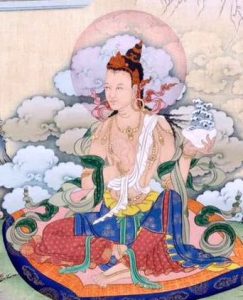
In a previous life, Yeshe Tsogyal was a merchant who went before the former Buddha and vowed to only be reborn for the benefit of beings. Subsequently, she manifested as the Indian goddess Ganga, who sprang from Lord Shiva’s topknot to flow as the River Ganges and as Sarasvati, the Indian goddess of knowledge, language, and music. According to some accounts, Padmasambhava invoked Sarasvati to manifest as a woman who would help disseminate the teachings of the secret mantra. Yeshe Tsogyal is considered an emanation of the primordial female Buddha Samantabhadri, Vajrayogini, Tara and Buddhalochana.
She was born in 777 into the aristocratic Kharchen family of the Chokdro Dri area. As she was conceived, Yeshe Tsogyal’s mother dreamt a blue woman appeared in the sky and sent a star shooting into her womb. Nine months later, an exceedingly lovely baby girl was born. Her forehead bore the mark of crossed vajras, and her body gave off the fragrance of a lily. At the same time, a spring burst from the ground and formed a pond next to the house. It became a famous pilgrimage site called Tsogyal Lha-tso, the sacred lake of Tsogyal.
Several events occurred in her early life, which caused her to give rise to weariness with samsaric existence. Her first suitor brutally raped her and the second one fought over her. When King Trisong Detsen heard of Yeshe Tsogyal’s miraculous abilities and beauty, he sent a minister to bring her to the palace. As the minister arrived at her home, she fled and went to meditate in solitude. Eventually, she did become the consort and queen of King Trisong Detsen. Later the king offered her to his master Padmasambhava in gratitude for receiving all the empowerments, transmissions and pith instructions. Padmasambhava set her free, and she became his disciple. Yeshe Tsogyal received all his transmissions and gave rise to deep faith.
During the empowerments of the Eight Sadhanas, her flower fell on the sacred mandala of Vajrakila. Through practising the sadhana, she rapidly gained accomplishment. She spent years receiving all of Padmasambhava’s teachings and practising as his consort in solitude, becoming his heart-disciple and spiritual heir. Together, they travelled and practised all over Tibet, blessing hundreds of locations as places of spiritual power.
In Nepal, Yeshe Tosgyal restored a dead boy to life. With the gold she was offered in gratitude, she paid the ransom for the slave boy Sa-lé who was prophesied to be her spiritual consort.
Having attained the siddhi of unforgetting memory, she assimilated and collected all of the teachings that Padmasambhava gave in Tibet. At his command, she concealed many as ter in specific locations, in readiness for the future when their destined tertön would discover and reveal them for the benefit of beings.
In this way, she concealed the Khandro Nyingthig she received in Tidro of Zhotö in the Drikung valley. These were to be revealed by the tertön Pema Ledreltsal (1291-1319?), who would then be reborn as the omniscient master, Longchen Rabjam (1308-1363).
After Padmasambhava left Tibet, she remained for many years securing the teachings, re-concealing ter and benefitting countless beings. In 837, as her life drew to an end, she departed from Shang Zabulung and flew through the sky to Zangdok Palri, Padmasambhava’s pure land.
